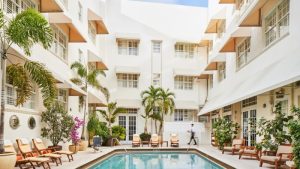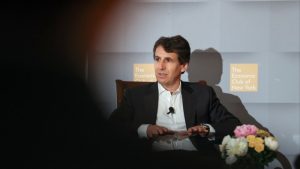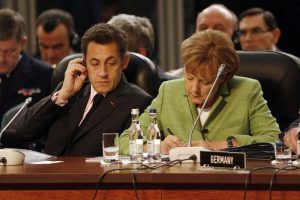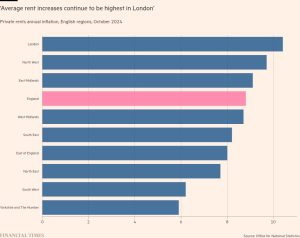the city skyline as ‘museum of architecture’
This article is part of FT Globetrotter’s guide to Hong Kong
Hong Kong’s incredible density and three-dimensional complexity is characterised by its towers. It is intensified, however, by a network of layers of circulation. There is no single street level but rather a lattice: pavements, bridges, escalators, stairs, covered walkways and air-conditioned sky-bridges. While wandering through the city, you might find yourself in a corporate lobby or sharing a glazed bridge with office workers, sharp-suited lawyers or lounging nannies, picnicking on their day off in ingeniously constructed cardboard shelters.
You’ll also find a tightly focused collection of some of the finest towers and skyscrapers in Asia, or indeed anywhere. The city districts of Central and Admiralty have become a kind of museum of architecture, a wonderful tracking of trends and technology over the past 75 years or so. There is not much left from earlier periods — with the exception of the occasional sculptural lion, cannon or war memorial — but that does not limit its range of expression.
You can cover this display of architecture easily and freely. The myriad walkways are not always easily navigable, but they lend themselves to a leisurely, compact architecture walking tour, which, if you can find your way around, involves barely any walking at all.
The Henderson (Zaha Hadid Architects)
2 Murray Road, Central

The newest and shiniest, most transparent, most expensive and most public of this group of towers is the Henderson. From the office of Zaha Hadid Architects, it is one of the biggest and best projects the practice has completed since Hadid died in 2016.
The 36-storey tower sits on what is said to have been the world’s most expensive building plot per square foot. It looks like a bundle of thick glass rods tied together in a low waist, with glass panels in hundreds of complex curvatures — a manufacturing feat only made possible by computer-aided design and production. Organic and fluid, this is a significant and elegant tower.


It is also, for an upscale corporate office, remarkably accessible, tied into the island’s network of elevated walkways. There are lush and intimate tropical gardens at an elevated lobby level and, above these, snaking, silvery and sinuous sky-bridges act as canopies.
The third-floor office lobby, with its Jeff Koons balloon sculpture, is open to the public. As is the lower lobby with its extraordinary scooped golden ceiling. Auction house Christie’s has taken space inside too, meaning its floors will be filled with a rotating show of art and the theatre of the auctions themselves.
Hadid herself had a major disappointment in Hong Kong when her radical 1983 design for a club on the Peak — the winner of an architectural competition — remained unbuilt. This is, at least in part, a small (well, 36-storey), posthumous compensation. Website; Directions
HSBC HQ (Foster + Partners)
1 Queens Road central, Central


Famously the most expensive building in the world when it was completed in 1986, this ingenious, 183m-tall tower cost about $670mn and took seven years to build — a glacial pace by Hong Kong standards. The result was a daring, extravagant, high-tech fantasia: the perfect symbol of the city’s new era as a global financial hub.
Using steel manufactured in Glasgow shipyards, its suspended structure (huge trusses that look like pairs of welded-together coat hangers) allows the interior to be expansively column-free. Whereas the centre of a tower would normally be dominated by a clunky concrete core, here it is all space and light, emphasised by Foster’s complex systems of mirrors.

One of its most memorable features, enabled by the structural design, is an open-air yet covered space at the base of the tower. The plaza here is busy and buzzy during the week, with escalators taking workers up into the bulging bowels of the building; on Sundays it becomes a place to picnic, a crowded, good-natured festival of food unwrapped from foil and Tupperware. During the demonstrations of 2011-12 and 2019–20, the plaza also became a focus for protesters. It seems a little ironic that this private space beneath a towering symbol of the colonial era should become a place to express independence, yet that is exactly what happened. It remains a charged and fascinating example of the potential of architecture to marry public and private realms. Website; Directions
Bank of China (IM Pei)
1 Garden Road, central
Built at least in part as a riposte to Foster’s theatrical HSBC tower, the Bank of China’s new HQ was the tallest in Asia when it opened in 1990. It’s the work of Chinese-American architect IM Pei, whose father had been the manager of the Hong Kong branch of the bank and was thus steeped in its culture, even if he had been based in New York for his whole career.


The tower he designed has a prismatic plan with distinctive X-bracing, so that in all dimensions it appears to be defined by diagonals and its crown is a simple triangular point. Despite its unpromising site — hemmed in on all sides by extremely busy roads and accessible only by an elevated walkway — Pei managed to make a very pleasant garden at its base, replete with water features and fully feng shui-ed.
Its entrance is solid and oddly neoclassical (considering the rigorous Modernist abstraction of the tower) and the interiors (some of which are accessible, including the large, airy and impressive banking hall) look a little dated — all marble surfaces, corporate furniture and plastic plants. But the tower remains a distinctive presence on the skyline, all the more so when its diagonal bracing is illuminated in garishly vivid colours at night. Directions
Hong Kong Club Building (Harry Seidler)
3a Chater Road, Central

Controversially replacing a Victorian, Renaissance-style building and one of the island’s most impressive colonial structures, this chunky tower was designed by Harry Seidler. The Austrian-born Australian architect had studied with Bauhaus émigrés Walter Gropius, Marcel Breuer (for whom he also briefly worked) and Josef Albers, and is credited with bringing that rigorous brand of Modernism to Australia.
This 21-storey structure was completed in 1984, housing the club on its lower four floors and offices above. It’s an elegant, unusual building; its windows are virtually invisible, its façade like some kind of strange washboard. Pre-empting Foster’s HSBC HQ, Seidler’s tower also avoids the use of internal columns, while the club interiors are a Futurist landscape of concrete elements and atria, sitting somewhere between Frank Lloyd Wright’s later whimsies and John Portman’s radical late-20th-century hotels.
It’s not the most accessible building and is best viewed from above — from The Henderson, for example. Directions
Lippo (formerly Bond) Centre (Paul Rudolph)
89 Queensway, Admiralty

Paul Rudolph was a hugely influential architect in the US in the 1960s and ’70s. His buildings were complex and Brutalist; while some became a focus for the reaction against Modernism, many have since been heedlessly demolished. By the time he designed this tower — which was completed in 1988 — his version of Brutalism had fallen out of fashion in the west, and his robust concrete had been replaced in the corporate world by mirrored glass. Here he offered a strange kind of hybrid: a mirror-shaded Brutalism, which sounds utterly counterintuitive.

It’s an almost retro sci-fi-looking building, its Terminator twin towers standing on concrete columns and composed of a series of interlocking forms. Oddly, I think it looks more modern now than it did when it was built. Rudolph, like Seidler, was taught by Bauhaus founder Gropius and was a classmate of IM Pei’s, so there is a fascinating, if not always scrutable, conversation going on between these buildings. They are competing products of second-generation Modernism. The base of the Lippo Centre is a mess of traffic and walkways and it appears in curious isolation: a version of the future we somehow find hard to access. Website; Directions
Jardine House (Palmer & Turner)
1 Connaught Place, Central
Perforated with more than 1,000 porthole windows, Jardine House is the daddy of Hong Kong skyscrapers. At 52 storeys, it was the tallest not only in Hong Kong but in the whole of Asia when it was completed in 1973. The erstwhile HQ of British multinational Jardine Matheson is now a kind of heritage building, a survivor amid the island’s relentlessly renewing skyline. And it has lasted well. It still has an impressive presence.


The round openings in the metal cladding were known as “moon windows” — a little touch of feng shui, which understands circular forms as lunar symbols and also as ciphers for coins and wealth. They don’t admit a huge amount of light or afford incredible views but they do make for an enigmatic, inscrutable envelope.
The tower was designed by Palmer & Turner, a Hong Kong practice whose early work included many of the most extravagant colonial-era buildings in Hong Kong and Shanghai (such as the latter’s huge 1920s HSBC building, Bank of China and the Peace Hotel, all on the Bund). The building itself is not accessible but there are shops and restaurants in the basement levels beneath. Website; Directions
Old Bank of China Building (Palmer & Turner)
2a Des Voeux Road, Central


Only two decades separate this building and Jardine House, yet it might as well as be a century or more. Opened in 1950, the old Bank of China building was built on the site of Hong Kong’s former City Hall in a (very) late-Art Deco manner, with a touch of Shanghai’s Bund and a dash of Gilded Age New York skyscraper. Its bulky, stepped form recalls the setbacks of Manhattan and Chicago skyscrapers. It is solid, maybe even a little stolid, with an echo of the grand, if slightly soulless Mao-era buildings of the same era on the mainland.
Also designed by Palmer & Turner, this was one of the last old-style towers before Modernism swept away everything before it. The banking hall has been significantly altered and looks a little cheesy today. But the top floors — where the late interior designer and FT columnist David Tang was let loose to create his retro-shabby-chic China Club — remain a joyful evocation of early-20th-century Shanghai. It is a real delight.
What’s your favourite high-rise in Hong Kong? Tell us in the comments below. And follow FT Globetrotter on Instagram at @FTGlobetrotter
Cities with the FT

FT Globetrotter, our insider guides to some of the world’s greatest cities, offers expert advice on eating and drinking, exercise, art and culture — and much more
Find us in Hong Kong, Tokyo, New York, London, Paris, Rome, Frankfurt, Singapore, Miami, Toronto, Madrid, Melbourne, Copenhagen, Zürich, Vancouver and Edinburgh
#city #skyline #museum #architecture







